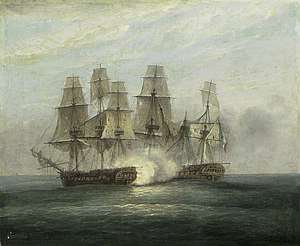HMS Didon (1805)
Didon was a Virginie-class 40-gun frigate of the French Navy. Captured by the British in 1805, she went on to serve briefly in the Royal Navy as the 38-gun fifth-rate HMS Didon until she was sold in 1810.
 The engagement between HMS Phoenix and Didon, 10 August 1805, by Thomas Luny | |
| History | |
|---|---|
| Name: | Didon |
| Namesake: | Dido |
| Builder: | Enterprise Ethéart, Saint Malo (Construteurs: François Pestel and Pierre Ozanne) |
| Laid down: | September 1796 |
| Launched: | 1 August 1799 |
| Captured: | on 10 August 1805 |
| Name: | HMS Didon |
| In service: | Captured on 10 August 1805 |
| Fate: | Broken up August 1811 |
| General characteristics [1] | |
| Class and type: | Virginie-class frigate |
| Displacement: | 1,400 tons (French)[2] |
| Tons burthen: | 1,09042⁄94 (bm) |
| Length: |
|
| Beam: | 40 ft 1 in (12.2 m) |
| Depth of hold: | 12 ft 10 in (3.9 m) |
| Sail plan: | Full-rigged ship |
| Complement: |
|
| Armament: |
|
French service
Laid down in 1796 as Fâcheuse, she was renamed to Didon in 1799, the year of her launch.
On 13 October 1803, she captured a British brig. She later took part in the Battle of Cape Finisterre in 1805.
Capture
_(14773044471).jpg)
While attempting to rejoin the French fleet of Allemand's expedition of 1805, she encountered HMS Phoenix, Captain Thomas Baker, on 10 August 1805, off Cape Finisterre, and struck at 43°16′N 12°14′W.[3]
Captain Milius, of Didon, maneuvered adroitly, and casualties on both sides were heavy. The 4-hour fight cost Didon 27 men killed and 44 wounded. Phoenix lost 12 men killed and 28 wounded.[4] Lloyd's Patriotic Fund awarded Baker a sword worth 100 guineas.[5] In 1847 the Admiralty awarded the Naval General Service Medal with clasp, "Phoenix 10 Augt. 1805".[6]
Baker took Didon in tow and sailed towards Gibraltar. By good fortune and skilful sailing he avoided encountering the Franco-Spanish fleet that had just left Cadiz. Instead of continuing onward, Baker changed direction and sailed for England.[7]
British service and fate
Didon arrived at Plymouth on 4 September 1805.[1] The Navy took her into British service as HMS Didon; she is the only ship of the Royal Navy to have borne this name. The Royal Navy commissioned Didon under the command of Captain Thomas Baker in November. She was paid off in 1807 and placed into Ordinary the same year.[1] The Navy commenced major repairs on Didon in May, but then cancelled the work. Didon was broken up in August 1811.[1]
Citations
Citations
- Winfield (2008), p. 176.
- Winfield & Roberts (2015), p. 141.
- "No. 15838". The London Gazette. 27 August 1805. p. 1091.
- "No. 15840". The London Gazette. 3 September 1805. p. 1115.
- Long (1895), p. 400.
- "No. 20939". The London Gazette. 26 January 1849. p. 240.
- Long (1895), pp. 127-8.
References
- Colledge, J. J.; Warlow, Ben (2006) [1969]. Ships of the Royal Navy: The Complete Record of all Fighting Ships of the Royal Navy (Rev. ed.). London: Chatham Publishing. ISBN 978-1-86176-281-8.
- Long, William H. (1895) Medals of the British navy and how they were won: with a list of those officers, who for their gallant conduct were granted honorary swords and plate by the Committee of the Patriotic Fund. (London: Norie & Wilson).
- Winfield, Rif (2008). British Warships in the Age of Sail 1793–1817: Design, Construction, Careers and Fates. Seaforth Publishing. ISBN 1-86176-246-1.CS1 maint: ref=harv (link)
- Winfield, Rif; Roberts, Stephen S. (2015). French Warships in the Age of Sail 1786–1861: Design Construction, Careers and Fates. Seaforth Publishing. ISBN 978-1-84832-204-2.CS1 maint: ref=harv (link)
External links
